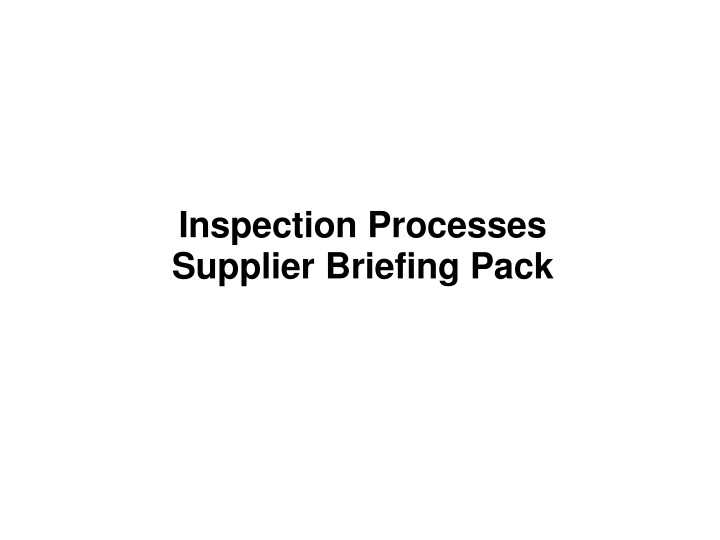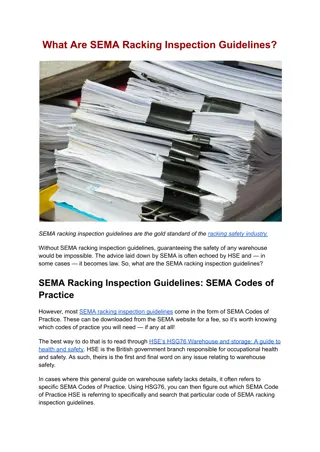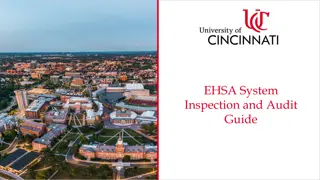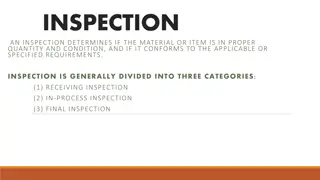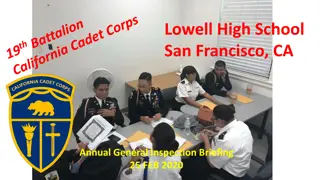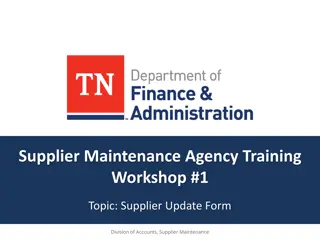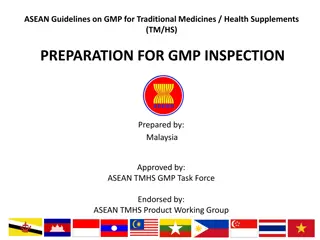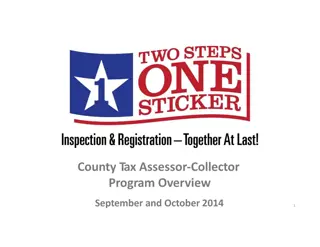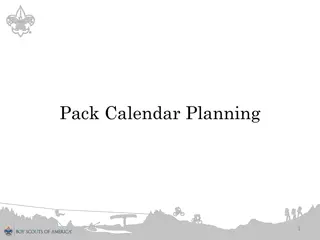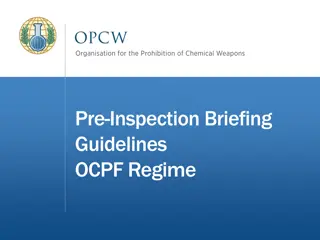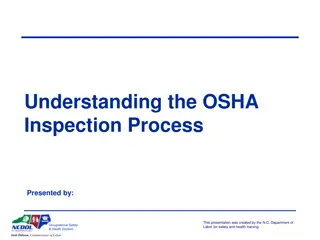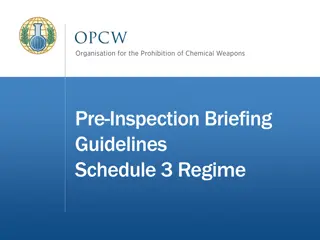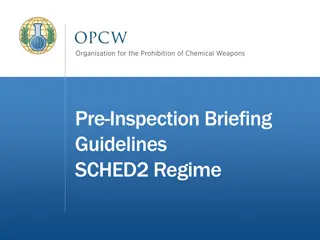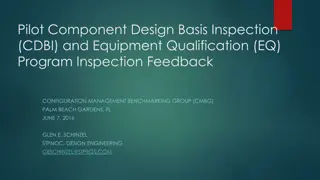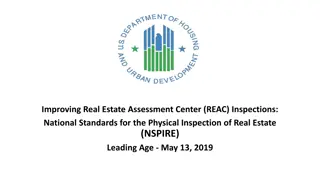Supplier Briefing Pack for Inspection Processes
Inspection processes are crucial steps in ensuring product quality and compliance with specifications. This briefing pack covers general requirements, visual inspection, dimensional inspection, non-destructive testing, calibration, control and measuring equipment, and inspection records. Emphasis is placed on ensuring accurate inspection results, batch integrity, and adherence to acceptance criteria. Visual inspection plays a key role post-production to detect changes in visual appearance and ensure products meet specifications without damage or contamination.
Download Presentation

Please find below an Image/Link to download the presentation.
The content on the website is provided AS IS for your information and personal use only. It may not be sold, licensed, or shared on other websites without obtaining consent from the author.If you encounter any issues during the download, it is possible that the publisher has removed the file from their server.
You are allowed to download the files provided on this website for personal or commercial use, subject to the condition that they are used lawfully. All files are the property of their respective owners.
The content on the website is provided AS IS for your information and personal use only. It may not be sold, licensed, or shared on other websites without obtaining consent from the author.
E N D
Presentation Transcript
Inspection Processes Supplier Briefing Pack
Inspection Processes - List of Contents General Requirements Visual Inspection Dimensional Inspection Non-destructive Testing Calibration Control and Measuring Equipment Inspection Records SABRe : Inspection Processes - Supplier Briefing Pack Issue 3.0 : April 2008
Inspection Processes : General Requirements Inspection is the step within a business process at which a product is checked to confirm that it meets the specification or design intent. Detail Drawing / Repair Scheme / Technical Specification / Quality Acceptance Standard etc.) , allied to a definition of the inspection technique(s) to be used. The inputs to the inspection process are the criteria to be inspected against (e.g. part of the overall inspection requirements. The type of inspection to be used is an input to the process - as an integral acceptance or rejection of the specific operation and / or product(s) concerned. Acceptance criteria should also be specified, with the output being either recorded against the product / feature being inspected ; this is particularly important when inspecting batches of product(s). A systematic approach shall be employed to ensure inspection results are preserved and also be free of any potential contaminants (e.g. swarf, waste etc.) The inspection location(s) shall be large enough to ensure batch integrity can be measurement, including temperature (where relevant), appropriate illumination to adequately highlight measurement equipment, together with those features being visually / dimensionally inspected or assessed. Environmental conditions shall be maintained to support accurate
Inspection Processes : Visual Inspection Following a production, processing, assembly or repair operation (as appropriate), visual inspection may be specified to detect changes in visual appearance in order to: completed satisfactorily - in accordance with specification requirements, are physically / operationally functional (where applicable) and free from damage. Confirm such operations (e.g. surface coatings, assembly, testing etc.) have been treatment, welding, identity markings etc.). Detect that an operation has been completed unsatisfactorily (e.g. incorrect heat swarf, blasting media, tooling etc.) and have similarly incurred no handling damage prior to customer despatch. Confirm that product(s) are free from contamination by foreign bodies (e.g. specifications (e.g. identity markings, labelling, protection / packaging etc.) have been correctly incorporated refer to Protection, Packaging and Labelling Processes for additional detail. Ensure that any special customer requirements detailed on the purchase order / technical Depending on what is being inspected and the potential for any non-conformance that could be present, the supplier(s) technical authority (e.g. Engineering, Quality, Laboratory etc.) may specify additional Visual inspection controls to ensure that accurate discrimination between acceptable and unacceptable conditions can both be successfully and consistently achieved. SABRe : Inspection Processes - Supplier Briefing Pack Issue 3.0 : April 2008
Inspection Processes : Visual Inspection (Contd.) verification and periodically re-assessed as an integral part of overall quality planning activities. The capability to conduct inspection adequately should be subject to product or assembly and associated production processes ; this should also be subject to periodic re-assessment and / or implementation of additional training where necessary. Inspection personnel should have adequate background knowledge of the electrical wiring / harness assemblies) - satisfactory colour perception / vision may also be a requirement (i.e. the inspector requires correct colour acuity and should be tested accordingly.) Dependent upon the product configuration / application (e.g. colour coded SABRe : Inspection Processes - Supplier Briefing Pack Issue 3.0 : April 2008
Inspection Processes : Dimensional Inspection Dimensional Inspection shall take place at specified stages in the production / assembly or repair process to verify conformance to specified requirements : This shall be achieved by the use of measuring equipment that has a sufficient level of resolution for measuring the dimensional tolerance of the product feature being inspected - special to product equipment should be specified as / where necessary. Measurement devices and the inspection standard to be achieved should be subject to the same units of measurement (e.g. metric / imperial) to avoid the unnecessary application of conversion factors or calculations in the workplace environment. - which if incorrect, could adversely influence the acceptance / rejection criteria. All measuring equipment (inc. personal items) shall be in calibration when available for use, registered within the supplier(s) overall calibration system and controlled accordingly. In the event of damage being incurred during use (e.g. by dropping), previously designated in calibration equipment should be withdrawn from immediate use , subjected to re-calibration and re-identified accordingly within the supplier s gauge and measurement calibration system, prior to any further issue and / or usage. Every effort shall be made to reduce the total variation within the measurement process to a minimum. Where necessary, it is permissible to repeat a measurement several times, calculate an average value and use this average value to sentence the product. SABRe : Inspection Processes - Supplier Briefing Pack Issue 3.0 : April 2008
Inspection Processes : Dimensional Inspection Unless prior / formal agreement has been received the use of Sampling Inspection techniques is not permitted on any product(s).This includes any product or operations which 1sttier suppliers may have sourced with relevant sub-tier suppliers. Should any doubt exist over inspection criteria on products scheduled for delivery, please consult the relevant controlling technical authority from the site placing the purchase order(s) - prior to any final release / shipment of finished product(s). SABRe : Inspection Processes - Supplier Briefing Pack Issue 3.0 : April 2008
Inspection Processes : Non-destructive Testing All NDT operations shall be undertaken in accordance with the governing engineering definition and / or technical specification(s) - as applicable. Where such work is being undertaken in house , 1sttier suppliers shall hold the requisite / current approvals for both the process operations and operating / inspection personnel - as appropriate. Suppliers of design / make products which are manufactured and tested to their engineering definition and who may utilise their own approved supplier network shall be expected to operate in a comparable manner and be able to demonstrate equivalency of control / certification - as appropriate. SABRe : Inspection Processes - Supplier Briefing Pack Issue 3.0 : April 2008
Inspection Processes - Calibration Control Whilst the following points are provided for guidance, it is recommended they are implemented as good practice in order to ensure a robust method of control and verification of measurement equipment: General Control and Verification of Measurement Equipment: accordance with ISO 10012 as referenced within ISO 9001 and AS / EN 9100 (as guidance). A suppliers calibration system should be maintained in accordance with ISO 10360, if an external company (i.e. Service Provider) is used to verify a suppliers CMM - this should be done in accordance with ISO 10360. It is recommended that Co-ordinate Measuring Machines (CMM s) are verified in Thermal and Environmental Control - Requirements for Measurement Rooms: enormously and these effects must be taken into account when measuring components with tight tolerances. The larger the component the more significant is the effect; component design specifications and all measuring equipment assume measurements are carried out at the standard temperature of 20 degrees Centigrade. Thermal control within manufacturing and measuring areas varies SABRe : Inspection Processes - Supplier Briefing Pack Issue 3.0 : April 2008
Inspection Processes : Inspection Records. Accurate records shall be maintained and retained to support the implementation and effective management of each stage of the overall manufacturing and / or inspection process - where appropriate. Record retention periods / storage and retrieval arrangements shall be in accordance with any regulatory or customer requirements applicable to documentation and data. SABRe : Inspection Processes - Supplier Briefing Pack Issue 3.0 : April 2008
